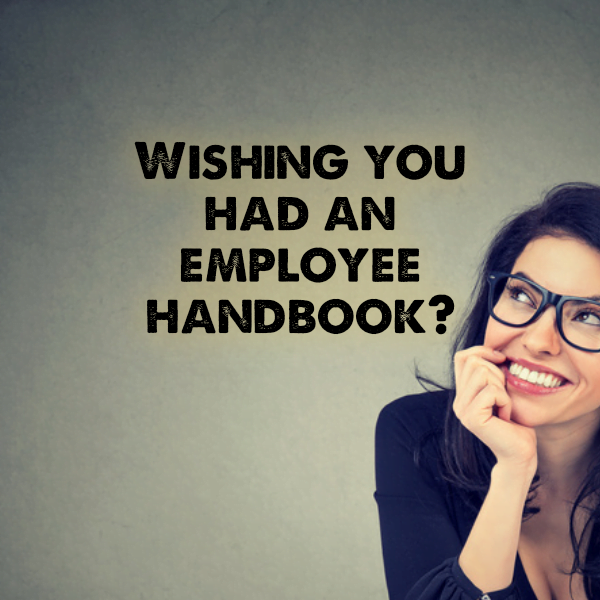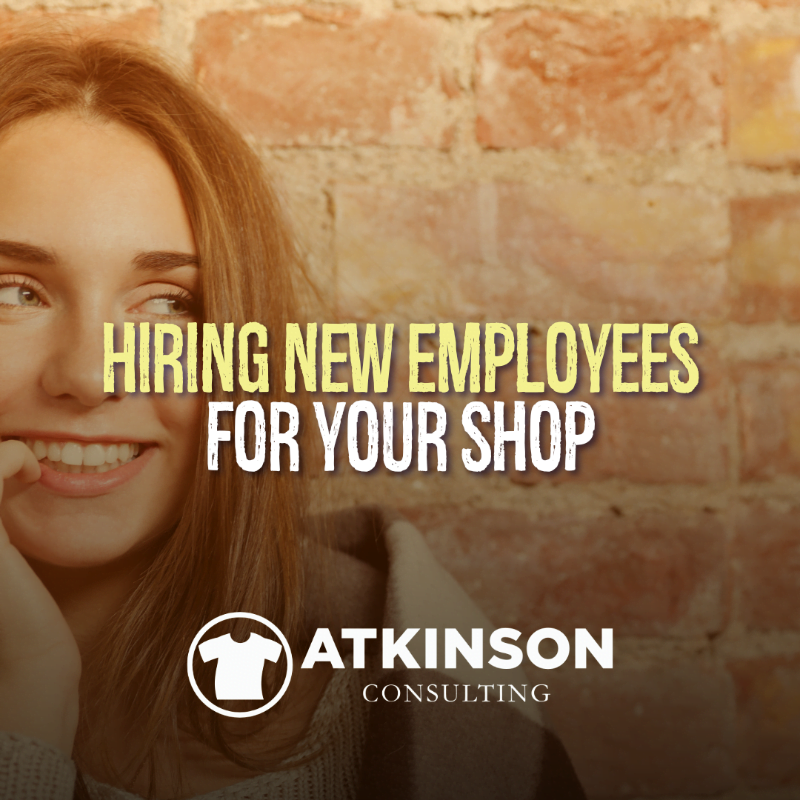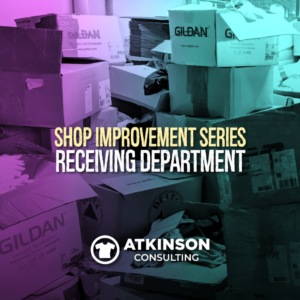A shop owner sent me an email earlier this week and wanted some guidance on hiring new employees for the shop.
I counsel shop owners constantly on this in coaching sessions but haven’t really dug into it with an article yet.
So, bingo…here we go!
Hiring For This Industry
Let’s face it. This industry is tough to hire for usually. Absolutely nobody knows what we do, or how we do it. Decorating a shirt is magic for most people.
Sure, there are folks that have experience and could be available for you to hire. However, for the most part, the talent pool around you is much larger with inexperienced people for apparel decorating industry skills.
Therefore, you will recruit better and raise the available number of applicants if you look for other things besides industry skill. This is that age-old maxim, “Hire for Attitude, Train for Skill” comes into play.
I just wanted to preface this article with the notion that if you build your employee hiring process with the idea that you hire a better person first, and skillset second, you may have better results in the long term.
So many shops get cornered by focusing on the skill and bringing in people with questionable character and work habits simply because they can run some equipment.
Don’t do that.
Create A Hiring Process
Regardless of the position, the first step you need to consider when even thinking about hiring is building a hiring process for your shop. This means that you are going to do things a certain way, every time, to achieve predictable and better results.
When I think about hiring people, I want the new hire to be capable of learning a job and having a career several levels above the advertised position might be about. For example, I want the entry-level job seeker to be eventually trained to run some equipment or a production supervisor to be capable of becoming the general manager.
Also, when we bring people onto our team, they should get cross training in different areas to flesh out their skill set and usefulness to the shop. I call this the Rule of 3. This means that for each core task in your company, there are at least three competent people that can handle it.
Start With A Job Description
The first step in this new hiring process is going to be focused on using a written job description. This doesn’t have to be an encyclopedia of every task the person is going to do but should include the basics.
The reason this is important is how can you advertise for the position or recruit someone if you can’t articulate what they will be doing for you? What key responsibilities will they have? Can you outline the skill set or background they need? What is the compensation package and benefits that they will earn?
Here is an example of a Job Description for a Production Manager.
You can use this as a template for your shop. Job descriptions act as an outline for putting your thoughts together for the role the new hire will play. Sure, it’s easy to say that “they will do everything I tell them to”, but how do you interview people based on that? It’s better to outline exactly what you are looking for your new team members.
Here are some key ideas for you to consider when writing a job description for any position in your business:
Key Ideas for a Job Description
- Where does this position fit on the companies organization chart? Who will be the person’s direct supervisor? Get them involved in picking their team.
- Salary range. You should publish it when advertising for the position. Doing so allows for the individual to consider the salary range before applying for the job.
- Exempt or Non-Exempt position – A non-exempt employee is entitled to overtime pay through the Fair Labor Standards Act (FLSA). Employers are required to pay time and a half the employee’s regular rate of pay when they work more than 40 hours in a given pay week. How are you classifying this role? Consider this before you start interviewing.
- Job Summary – This is a few sentences that sum up the primary work for the position.
- Essential Duties and Responsibilities – This breaks down the core tasks that they will be handling for you.
- Supervisory Responsibilities – Do they manage people? If so, outline that.
- Qualifications – What makes them an ideal candidate?
- Education and/or Experience – What background is important for this role?
- Language, Math and Reasoning Skills – What do you need for this position?
- Physical Demands and the Work Environment – Outline what it is like for the position.
Hire Slow, Fire Fast
The people that work for you play an incredible role in the success or lack of success that your business will have. Rethink how you consider people as if you were fielding a sports team.
Your goal is to have the best players on your team that you can get. Varsity players all. This is the first step in beating the competition.
So, are you letting Junior Varsity players on the team? Maybe even some that wouldn’t even make the JV squad?
Why?
Don’t just accept anyone that can fog a mirror.
The best employees want to work with other best employees. If you were on a sports team when you were younger, you may remember the difference between the Varsity and JV players. The skill level, work ethic, attitude, teamwork, and all-around excellence was different.
For your company, finding the best people to work for you can be a challenge. But not one that is insurmountable.
We Can Train
I believe that you can train people on the skills for this industry in a relatively short amount of time. What I would rather have is a really good person to train. This is a key factor in their success, and ultimately the companies success.
Over the years, I’ve hired scores of people in every department for a shop. Managers, regular workers, artists, from all backgrounds and skills sets. I’d like to think that my track record for hiring is pretty good.
I’ll be honest, not every hire worked out. But the ones that came aboard succeeded because they had something inside that made them special.
That’s what I look for more than anything. The inner fire to succeed. Professionalism. Teamwork. Humor. Intelligence.
For this industry, here are the traits I look for in people:
Decorated Apparel Industry Success Traits
- Teamwork – Were they on a team? In sports, or work.
- Hand/Eye Coordination – Do they have hobbies or previous work that involved their hands?
- Follows Directions – A lot of what we do is process oriented with steps and checklists.
- Communication – Can they speak well? Do they ask questions?
- Humor – This is a tough business and sometimes demanding. Is this someone you want to be around, or would fit in with your team?
- Inquisitive – Are they interested in learning?
- Action Oriented – They are a doer above all else.
- Creativity – Not only with design but with problem-solving.
- Work Ethic – This isn’t a job for slackers.
- Observant – They notice stuff. Is that crooked or the wrong color?
Do You Have What It Takes?
So, all in all, it comes down to who do you want on your team? During a phone or in-person interview, your purpose is to essentially find out, “Do you have what it takes to work here?”
They may not know how to separate a simulated process file, hoop a fleece jacket, or reclaim a screen. Starting off, virtually nobody does. Those are things that can be taught.
What I want to know is can they learn? Do they fit in? Will they be a team player? Are they simply a clock puncher?
You are looking for proof of that.
The sad part is that you only have a few moments to decide that. One, maybe two interviews. Some conversation. A resume and an application.
It’s scary to pick your team from that.
The hiring process that I’ve used the past is like the TV show Survivor. At each short segment, the job applicant either makes it to the next round or gets voted off the island.
Here is what has worked for me in the past.
Hiring New Employees Step 1
The job ad.
One thing that has worked very well is using your current employees to bird dog future employees. Pay them a bonus of $250 for any new hire that makes it to 90 days that they refer. I like this process because most of the time, the candidates that they send already know a lot about your company based on what they have been told.
Remember, your Varsity players want other Varsity players to join your team.
If that doesn’t work and you want to go the more traditional route, try placing ads in Zip Recruiter, Indeed, or a local job placement ad service. Be specific about the position, and always include the pay range. This eliminates potential pay challenges as any candidate knows going in what to expect.
If you truly want the best people in this industry to work for you, try to pay your staff about 10%-20% above what the going rate for those jobs are where you are based.
Hiring New Employees Step 2
Make it easy to apply for the job. Post the notice for openings on your website, and include a branded form for any candidate to fill out. Include a method for uploading a resume.
For walk-ins, make sure you have the same application in paper form, or accessible on a computer tablet. Do not interview anyone without an application.
Even though there is a low unemployment rate, a good number of people are under-employed. This means that they have a job, but it is usually doing something that they would consider changing if the right opportunity presented itself.
Your company is that right opportunity. Are you marketing that to the talent pool?
You have to sell your company to potential workers just as if they were buying from you.
Results may vary depending on where you live, but I know shops that are advertising for positions right now that are getting 50-90 applications to choose from.
That could be you.
Hiring New Employees Step 3
The phone call. Reading the application and their resume, you have decided you like a few of the applications and it’s time to reach out.
Great!
Don’t just have them come in. Take some time for a five to ten-minute phone call with each of the ones you want to interview. This chat can weed out some of the potential candidates that might not fit in before you spend any time with them in person.
Do you get a good vibe when you talk to them? Are they professional? Anything strikes you the wrong way?
Ask them about their previous job and why they left. What did they learn there? Have them talk briefly about the experience. If their response makes you more inquisitive about them, then book the in-person interview.
But, if they are not quite right don’t feel obligated to bring them in for a one-on-one chat. Don’t waste their or your time.
I like to schedule three to four interviews back to back on the day. Each will be scheduled for thirty minutes. Before you call an applicant, have that day and time in mind already.
Hiring New Employees Step 4
The appointment.
This is like an audition. By now, everyone you interview knows what to expect in a professional interview. They should come prepared, arrive early, and be ready to find out more about the job they applied for recently.
That’s why the little things matter. How do they present themselves? Did they arrive early? In their hand, is there a copy of their resume?
Bonus points if they have a list of written questions about your business.
When they arrive, have the receptionist or whoever greets them first write the time they walked in the door in the upper left-hand corner of the application. Make sure the application is completely filled out.
Then bring them into a closed-door office. Have another staff member in the room with you as an observer. You will be asking the questions and handling the interview. They are watching body language and making note of their responses.
You have already reviewed a portion of their resume on the phone, but now the chance to dig in deep.
Here are some questions that I’ve used in the past for interviewing potential candidates:
Interview Questions
“Tell me a story about being on a team or working on a project with a group. How did you fit in, was it successful, and what did you learn?”
“Why do you want to work here?”
“What did you think about our website? What is the one thing that stuck out for you?”
“In your professional career, what’s the biggest accomplishment or achievement that stands out? Why is that important to you?”
“We all make mistakes. Can you elaborate on one that you have made and what you learned to correct it so you don’t make it again?”
“Why are you leaving your current position with your employer?”
“How do you like to learn? Hands-on? By reading? With a video?”
“What excites you about working here?”
“Outside of work, what do you like to do with your time?”
“What brings you joy?”
“We are interviewing several people for this position. What’s the one thing that you want us to know about you that should give us the reason to hire you?”
Be Observant
During the interview, your helper is watching their body language as the candidate answers the questions. They are also listening in on both sides of the conversation. As you ask your questions, dig deeper with follow up questions to the candidate’s answers.
Everyone tries to put on a good show in an interview. Having someone else in the room is a huge help as they may catch something that you missed.
Body Language 101
Eye Behavior – This can be very revealing. Are they making eye contact? Where are they looking in the room when they are talking? It’s been said that if someone looks upward and to the right when telling a story they are making it up. If they look upward and to the left, they are recalling the information. Watch where the eyes go.
Mirroring – This is an easy one to look out for when observing body language. If the person you are interviewing copies your body position, this could mean that they are trying to establish a relationship with you. During the interview shift your body and do something else. If they copy you within a few moments this may be their intent. This is a good sign.
Observe Head Movement – If the person slowly nods their head while listening, this can indicate that they are listening or have approval on what you are saying. Faster head movement can indicate a lack of patience, that they want you to finish speaking, or that they have heard enough. Tilting the head sideways is an indication that they are interested in what you are saying.
Leaning In – When a person is leaning towards you this indicates that they are interested in what you are saying. It’s the classic “tell me more” position. On the other hand, leaning backward may indicate that they are not listening, or are disinterested in the conversation.
Arm Positions – The position of the arms in relation to the belly can indicate a lot of things. Arms crossed over the belly or chest is a classic body language cue of disinterest or being defensive. This blocking gesture can also indicate that they have something to hide. Arms open, exposing the belly and chest can indicate that they are receptive to the conversation or idea.
Hiring New Employees Step 5
You’ve asked your questions. They answered. The next step is a crucial one. Based on their answers and your immediate impression of them, is the candidate likely to be in the pool for consideration?
If so, then this is when you give them the shop tour and talk about the job duties more at length.
But if not, then just thank them for their time and let them know then that they are not a good fit for your company. Don’t say you will get back to them, as that is one more thing you will have to do later. Be honest and let them know now.
If the applicant is going to move on, start the shop tour. When you do this, purposely walk faster than normal. You want to see if the person keeps up. This is the “hustle meter test”.
While walking around the shop, stop and introduce them to your team. Especially in the area where they might be working. You want to see if they ask questions about the work, or ask questions with the team members.
Questions are a great sign. This means they are very interested in learning. Someone standing there blankly and waiting for something to happen could be an indicator that that’s how they work as well.
You are looking for engagement.
Hiring New Employees Step 6
After the tour, bring them back to the office for the wrap-up. The entire interview should last no longer than about thirty minutes.
At this point, they have discussed their history, have had a conversation with you about the job, and also have had a tour. To me, this point in the interview has always been a pivotal one.
This is when you say, “So, do you have any questions for me?”
Hopefully, they have a bunch. This can indicate that they are extremely interested in the position and working for your company. You have revealed a lot, but not everything. I always loved it when the applicant had questions, as that meant that they may have done some research or have had some serious consideration on working for the company.
If they say, “Nope, we’re all set.”, that either may be an indication that they won’t be a good candidate…or possibly you’ve answered everything. It all depends on how the dialog went earlier.
Hiring New Employees Step 7
After they leave, turn their resume or application over to the blank side. Jot down everything that you can recall on the paper. Impressions, questions, good points, bad points, etc. Have your helper give you their impressions too.
This is important to do fresh, as in a week or two later this is going to help you remember these details. Get everything down.
Then, the application and resume packet is placed in a folder for the position. If you are hiring for multiple positions, have a folder for each one. As you interview, rank the candidates with the best on top of the stack in the folder, and the next best underneath.
When you are satisfied that you have seen enough people, the leading candidate will be on the top of the stack. If when you call them to offer the job and they decline, your number two choice is already made.
Hiring New Employees Step 8
You’ve offered them the job. They accepted.
The next step is critical to their success at your company. And that is with your onboarding. Make sure you have a process for that. Don’t just throw them to the wolves and wish them good luck.
Make them feel welcome. Assign them a mentor to show them around and make them feel comfortable. If they are going to be using a computer, make sure their email already works, and they have passwords set up.
You want them to feel at home, and that they made the best decision of their lives. Imagine the dinner table conversation later. What do you want them to tell their family or their friends that night?
Remember, people don’t remember what you say, they remember how you made them feel.
“Hire people who are better than you are, then leave them to get on with it. Look for people who aim for remarkable, who will not settle for routine.” – David Ogilvy
“You are only as good as the people you hire.” – Ray Kroc
“You’ll have to hire people to expand your business. But it is a good discipline to really question if you need each and every hire.” – James Altucher

One thing you need as you expand your staff is a good rule book on how your shop handles the day to day challenges. Part of my “Shop Basic Info Pack” eBook contains a template that you can use to custom create an Employee Handbook in just a few moments.
Also in the eBook are sections on Business Plan templates, marketing, and a Screen-printing Production Dashboard. At $49, this eBook is packed with value. Get yours today!





